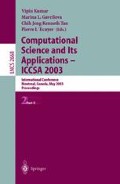Abstract
The randomization of scalar multiplication in ECC is one of the fundamental concepts in defense methods against side channel attacks. This paper proposes a countermeasure against simple and differential power analyses attacks through randomizing the transformed m-ary method based on a random m-ary recoding algorithm. Therefore, the power consumption is independent of the secret key. We show that the proposed algorithm has fewer computational cost than the previous countermeasures against power attacks in ECC. Accordingly, since the variable window width arrays and random computational tracks can resist against the SPA and DPA, the proposed countermeasure can provide a higher security for smartcards.
This research was supported by University IT Research Center Project.
Access this chapter
Tax calculation will be finalised at checkout
Purchases are for personal use only
Preview
Unable to display preview. Download preview PDF.
References
R. Anderson and M. Kuhn, “Tamper resistance-a cautionary note”, In Proceedings of the 2nd USENIX Workshop on Electronic Commerce, pp. 1–11, 1996.
P. Kocher, J. Jaffe, and B. Jun, “Differential Power Analysis”, In Proceedings of Advances in Cryptology-CRYTO’99, pp. 388–397, Springer-Verlag, 1999.
J.R. Rao and P. Rohatgi., “The EM Side-Channel(s)”, In Pre-Proceedings of Workshop on Cryptographic hardware and Embedded Systems-CHES’02, pp. 29–45, Springer-Verlag, 2002.
V. S. Miller, “Use of elliptic curve in cryptography”, In Advances in Cryptology-CRYPTO’85, LNCS 218, pp. 417–426, Springer-Verlag, 1986.
N. Koblitz, “Elliptic curve cryptosystems”, In Mathematics of Computation, Vol. 48, pp. 203–209, 1987.
J. S. Coron, “Resistance against differential power analysis for elliptic curve cryptosystems”, In Proceeding of Workshop on Cryptographic hardware and Embedded Systems-CHES’99, LNCS 1717, pp. 292–302, Springer-Verlag, 1999.
Yvonne Hitchcock and Paul Montague, “A New Elliptic curve scalar multiplication algorithm to resistant simple power analysis”, In Proceedings of Information Security and Privacy-ACISP’02, 7th Australian Conference, LNCS 2384, pp. 214–225, Springer-Verlag, 2002.
J. C. Ha and S. J. Moon, “Randomized signed-scalar multiplication of ECC to resist Power Attacks”, In Pre-Proceedings of Workshop on Cryptographic Hardware and Embedded Systems-CHES’02, pp. 553–565, Springer-Verlag, 2002.
B. Möller, “Securing elliptic curve point multiplication against side-channel attacks”, In Proceedings of Information Security Conference-ISC’01, LNCS 2200, pp. 324–334, Springer-Verlag, 2001.
P. Y. Liardet and N. P. Smart, “Preventing SPA/DPA in ECC systems using the Jacobi form”, In Proceedings of Workshop on Cryptographic hardware and Embedded Systems-CHES’01, LNCS 2162, pp. 391–401, Springer-Verlag, 2001.
I. F. Blake, G. Seroussi and N. P. Smart, Elliptic Curves in Cryptography, London Mathematical Society Lecture Note Series. 265, pp. 66–72, 1999.
Oswald E. and Aigner M., “Randomized Addition-Subtraction Chains as a Countermeasure against Power Attacks”, In Proceedings of Workshop on Cryptographic Hardware and Embedded Systems-CHES’01, LNCS 2162, pp. 39–50, Springer-Verlag, 2001.
C. D. Walter, “Some Security Aspects of the MIST Randomized Exponentiation Algorithm”, In Pre-Proceedings of Workshop on Cryptographic Hardware and Embedded Systems-CHES’02, pp. 277–291, Springer-Verlag, 2002.
K. ITOH, J. YAJIMA, M. TAKENAKA and N. TORII, “DPA Countermeasure by Improving the Window Method”, In Pre-Proceedings of Workshop on Cryptographic Hardware and Embedded Systems-CHES’02, pp. 304–319, Springer-Verlag, 2002.
Kris T., Moonmoon A. and Ingrid V., “A Dynamic and Differential CMOS Logic with Signal Independent Power Comsumption to Withstand Differential Power Analysis on Smart Cards”, In 28th European Solid-State Circuits Conference, 2002.
Okeya K. and Sakurai K., “Power analysis breaks elliptic curve cryptosystems even secure against the timing attack”, In Proceedings of INDOCRYPT’00, LNCS 1977, pp. 475–486, Springer-Verlag, 2000.
Okeya K. and Sakurai K., “A Second-Order DPA Attack Breaks aWindow-method based Countermeasure against Side Channel Attacks”, In Proceedings of Information Security Conference-ISC’02, LNCS2433, pp. 389–401, Springer-Verlag, 2002.
Okeya K. and Sakurai K., “On Insecurity of the Side Channel Attack Countermeasure using Addition-Subtraction Chains under Distinguishability between Addition and Doubling”, In Proceedings of Information Security and Privacy-ACISP’02, 7th Australian Conference, LNCS 2384, pp. 420–435, Springer-Verlag, 2002.
T. Izu, B. Moller and T. Takagi, “Improved Elliptic Curve Multiplication Methods Resistant against Side Channel Attacks”, In the proceedings of INDOCRYPT’02, LNCS 2551, pp. 296–313, Springer-Verlag, 2002.
C.D Walter, “Breaking the Liardet-Smart Randomized Exponentiation Algorithm”, In the proceedings of Cardis’02, USENIX, pp. 59–68, 2002.
T. S. Messerges, E. A. Dabbish, and R. H. Sloan, “Power Analysis Attacks on Modular Exponentiation in Smartcards”, In Proceeding of Workshop on Cryptographic hardware and Embedded Systems-CHES’99, LNCS 1717, pp. 144–157, Springer-Verlag, 1999.
Author information
Authors and Affiliations
Editor information
Editors and Affiliations
Rights and permissions
Copyright information
© 2003 Springer-Verlag Berlin Heidelberg
About this paper
Cite this paper
Ahn, M., Ha, J., Lee, H., Moon, S. (2003). A Random M-ary Method Based Countermeasure against Side Channel Attacks. In: Kumar, V., Gavrilova, M.L., Tan, C.J.K., L’Ecuyer, P. (eds) Computational Science and Its Applications — ICCSA 2003. ICCSA 2003. Lecture Notes in Computer Science, vol 2668. Springer, Berlin, Heidelberg. https://doi.org/10.1007/3-540-44843-8_36
Download citation
DOI: https://doi.org/10.1007/3-540-44843-8_36
Published:
Publisher Name: Springer, Berlin, Heidelberg
Print ISBN: 978-3-540-40161-2
Online ISBN: 978-3-540-44843-3
eBook Packages: Springer Book Archive

